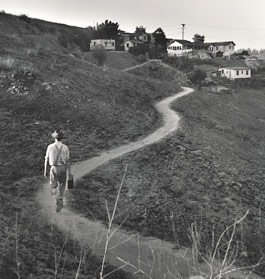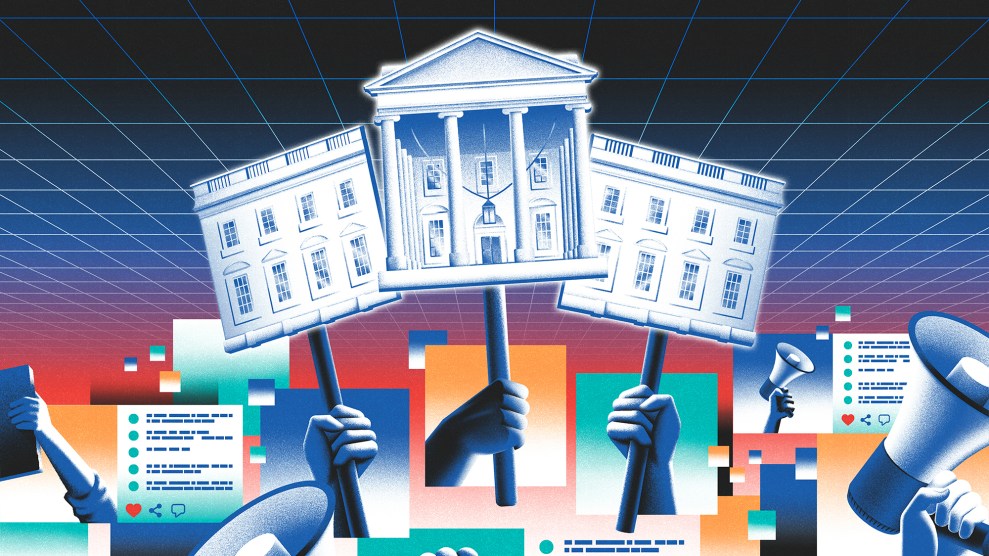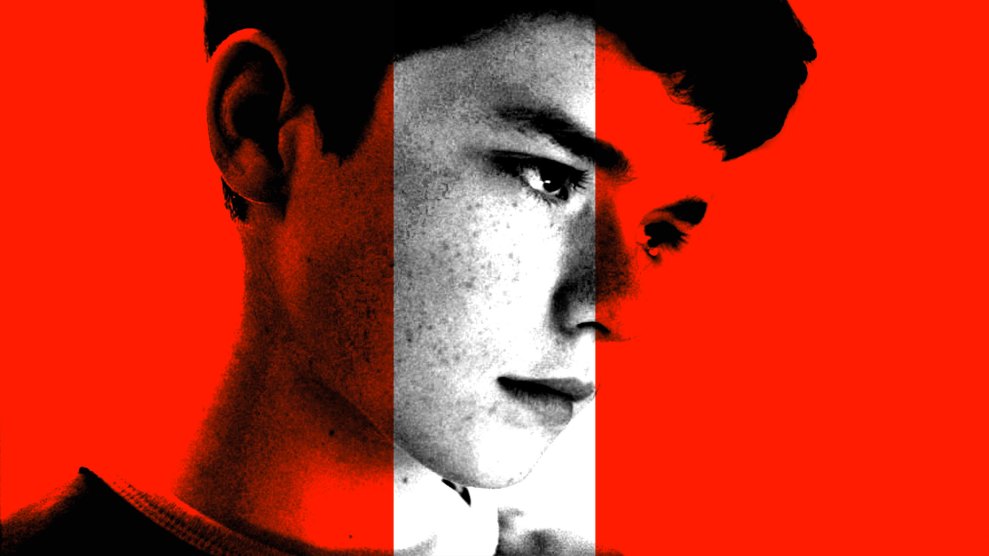
Photo: Don Normark
“SEE UP THERE?” asks Ry Cooder, pointing up a seemingly nondescript Los Angeles hill. “That’s where the viejitos, the old men who worked for the railroad, rented shacks, on that ridge right there. Now this is Academy Road,” he continues, swinging his white Toyota 4Runner around the corner of a residential street that’s somewhere between quaint and ramshackle. “There’s a WPA school down here—it was built in the ’30s, and the neighborhood was built around the school.”
Cooder’s remarkable new album is titled Chavez Ravine, and this little neighborhood is Solano Canyon, the last intact section of the 400-acre district that gave the project its name. One of the most celebrated guitarists alive, best known for his work on Buena Vista Social Club, Cooder has spent the last three years constructing an evocation of Chicano East L.A. in the ’40s and ’50s—and he has become so fluent in the history of these side streets that he can go door to door telling stories.
“This corner house? They’ve been in here since it was built, maybe 80 years ago,” he says, continuing the tour. “If you go up these steps you’re in a field that was never built on. And then there’s this wonderful, obscure, esoteric house here that I think was a rooming house and now it’s a one-family. I love this place—it really speaks. It’s got lots of secrets.”
As late as the 1940s, Chavez Ravine was an Old World enclave with 300 families of Mexican immigrants—a place where goats wandered freely and kids played in the dirt roads. But in 1950, following a city planning commission study of L.A.’s “blighted areas,” it was decided that Chavez Ravine would be cleared out to make way for a low-income public-housing project. Most families took the meager payout and didn’t challenge the authorities; when necessary, though, the city invoked the right of eminent domain, seized the land, and bulldozed the residences.
But the real estate lobby (which Cooder calls “hideous villains”) saw an opportunity, and cast the idea of public housing as “creeping socialism.” They accused the Los Angeles Housing Authority’s Frank Wilkinson of being a communist agent, and the FBI stepped in to squash the project. Eventually, the housing authority sold 170 acres of Chavez Ravine back to the city, which offered the site to Brooklyn Dodgers owner Walter O’Malley. After a voter referendum and a California Supreme Court decision, construction on Dodger Stadium began in 1961. It’s a classic Los Angeles story, full of shadowy deals and backroom corruption, reminiscent of Chinatown or a James Ellroy novel, and Cooder captures it with impressive complexity and nuance.
He drives through the adjacent fields of sprawling Elysian Park and further up into the hills before pulling to the side of the road to look down on the massive spread of the baseball stadium, perched above the city streets on a hill of its own. “That’s just the parking lot,” says Cooder, 58, from behind oversize yellow sunglasses. “You can see it was an enormous expanse. There’s a whole town under there. I love the fact that it’s high, it’s up. I wanted to say that in the music—that it was set apart, and when you were here, you were somewhere else for real.”
RY COODER HIMSELF seems vaguely out of time; in his checked shirt and slip-on Vans, speaking steadily but in no hurry, he exudes something like a beatnik cool (he even says “I dig it” with some frequency). His career defies easy explanation. He has recorded with the likes of the Rolling Stones, Neil Young, the Monkees, and Little Feat. His solo albums, explorations of “world music” long before such a term existed, have featured Hawaiian slack-key guitars, Tex-Mex accordions, and Indian flutes. He’s written scores for numerous films such as Paris, Texas and The Long Riders. His reputation as a guitarist is such that, as he hilariously recounts, Bob Dylan showed up at his door one night, unannounced and shabbily dressed, looking for help learning a Sleepy John Estes blues song (and giving the neighbors a good scare in the process). And all that came before Cooder produced Buena Vista Social Club, which won him a Grammy and introduced traditional Cuban music to the masses.
Yet in almost 40 years of dizzying musical globe-trotting, Cooder had never plumbed the idioms of his native Los Angeles. “I always thought East L.A. music was so dreamy and languid and kinda greasy,” he says. “I would think, something’s out there—I wonder what? I used to sneak my little East L.A. instrumental ideas into movie scores. If I saw an opening, we’d dream up some little low-rider song.”
About four years ago, Don Normark approached Cooder. As a young photography student, Normark had shot extensively in the Ravine, later assembling the book Chavez Ravine, 1949: A Los Angeles Story. He was planning a reunion with the families he’d photographed and was interested in turning it into a film. Cooder immediately agreed to help with the music. (The documentary recently premiered on PBS’s Independent Lens series.) He was familiar with Normark’s book, and knew the rough outlines of the Chavez Ravine story. “Most anybody of my age who lived in Los Angeles knows something about Chavez Ravine,” he says. “Mexican guys, East L.A. guys, and left-wing people like my parents know all about it. I’d heard it as a kid, but I didn’t know the details and I didn’t know the players.” As he started to look into the history, an obsession began.
His first stop was a visit to octogenarian singer Lalo Guerrero, whose pachuco songs were part of the Ravine soundtrack during the ’40s and ’50s. (The pachucos gained national attention during L.A.’s 1943 Zoot Suit Riots, when hundreds of sailors on shore leave attacked Chicano youth wearing the distinctive baggy clothing that was somehow interpreted by the media as evidence of their criminality. Not much changes.) Guerrero embodied East L.A.’s musical fusion of slinky Latin rhythms with the updated cool and harmonies of R&B, flavored with sprinkles of swing and boogie-woogie. Together, they worked up three songs, which gave the project its spiritual center. Cooder then visited local hero Little Willie G, lead singer of low-rider favorites Thee Midniters, and they knocked out a few more songs, both old and new. At that point, the guitarist could start to see something taking shape, but he still couldn’t quite envision what it was.
“I needed a story to go with this East L.A. thing,” he says. “You can’t just do the old songs; they’ve done those to perfection. Then I found this book, The Provisional City, that’s a history of public housing in L.A., and it told the whole story about the Ravine and the FBI and Frank Wilkinson. It was so vivid to me, so I thought, I’ll pretend to score the book. I found the mood I want, I found myself as a speaker—which is what you have to do, you can’t just be an observer, you have to get yourself located.”
It was at this point that Chavez Ravine took on extra-musical directions. “It was a quest and a study, and I had to work at it every day, like writing a book. I would go for my morning walk, I’d get an idea, and I’d spend the rest of the day working on that—if I needed to go see something, or find somebody, or look at photographs and architectural drawings. I think my wife worries about me sometimes, too much preoccupation, but I like to do it. What else would I do? I don’t know what else to do.”
Armed with his research, Cooder continued sketching out the mood, texture, and narrative of the album. Musicians including bassist Mike Elizondo (Dr. Dre’s musical right hand), jazz pianists Jacky Terrasson and Chucho Valdes, and East L.A. boogie king Don Tosti got involved. Cooder visited with Wilkinson, now 93 years old, who showed the musician the 132,000-page file the FBI kept on him, including details of an assassination plot that J. Edgar Hoover did nothing to prevent. (“He’s very proud of that,” notes Cooder.) Wilkinson even provided a cameo narrative to the album. More songs, in both English and Spanish, were written or found: the story of the Zoot Suit Riots, an account of a bulldozer driver, and even a tune sung in the voice of the scarred earth. Cooder also came up with the slightly loony character who helps tie the story together—a lonely “space vato” dropping in on the residents of Chavez Ravine in his UFO.
“The UFO allows you to take a different viewpoint,” Cooder explains. I look over, and he’s dead serious, weaving through freeway traffic as jazz plays softly on the radio. “If every song is in the past tense, that’s a drag, so you have to predict the future. And the Ravine would be a good place to land one of those things. So the guy gets out, looks around, and warns the people about the future—which enables somebody in the crowd to say, ‘Sir, you’re wrong, that can’t happen here.’ Which I really wanted to say, because everywhere I go, I’m thinking to myself, if you’d have said 10 years ago that a mutant tribe in Washington will take over, unplug the Constitution, wreck our country, and steal two presidential elections, everybody would have said that can’t happen. So every day we’re crossing that line, and that’s all I seem to be able to think about.”
“WHAT A MACHINE!” Cooder beams as he stands in a small garage called CJ’s, located at the entrance to the Santa Monica airport, a few blocks from where he grew up and not far from his current home. He runs a hand over the half-constructed ’50s-vintage ice cream truck that he’s having rebuilt. “It sits just so, I tell you. The slope is the thing—Good Humor figured that out.”
He’s seeing the new hubcaps (actually replicas from Taiwan) for the first time. In a few days, a low-rider specialist will put in the motor and the brakes. Then Cooder will ship the whole thing to San Antonio, where a young Chicano artist will paint a Chavez Ravine mural on the truck’s side; concurrently, a local artist is building a diorama of the old neighborhood that will fit in the back. What will he do with this rolling masterwork? Who knows—it won’t be completed until long after the album is out and its promotion is done. “This is for me,” he says, shuffling back through the parking lot. “I’ve been wanting an ice cream truck forever. You can’t just work and work and work—and this is worth it! This thing is something else.”
The truck is a reminder of the L.A. of old, the city of Cooder’s youth that still had rural areas and ties to the unreconstructed West and neighborhoods like Chavez Ravine that felt like distinct towns. “TV changed everything,” he says, shaking his head. “Advertising, consumerism, everything got brighter and faster. This airport is the last place that still has that same breezy, restful quality. If they do what they say they’re going to do—which is convert it into an office park—then I will leave Southern California never to return. That’s a blood oath.”
Los Angeles’ penchant for cultural erasure made his new project a dramatically different undertaking than Buena Vista. “This Chavez thing was like a big puzzle that was all spread out, you couldn’t even see the pieces,” he says, “whereas Buena Vista we essentially walked into it. In Cuba, it was like it was on a plate—if you go to Havana, especially seven or eight years ago, and walk down the street, everything’s there, the old people, the young people, the past and the present are one thing. It’s pre-media, pre-television, it’s all very viable and dynamic. [But] the change in life of L.A. from that time to this one is very extreme. People have it in their memory—but only a few.”
Indeed, one thing that ties the two undertakings together, sadly, is that Cooder concocted them just under the wire, before the aged musical principals involved passed away. For just as several of the Cuban maestros died soon after Buena Vista‘s release, so Lalo Guerrero and Don Tosti—the tangible connections to the Chavez Ravine of old, and the unique hybrid its music represented—did not live to see this album’s completion; their collaborations with Cooder were their final recording sessions.
“You’re always working against the clock,” says Cooder. “It makes you work really hard because you know that you might need something, and if somebody’s died and you got to them a week late, it’s just gone. You won’t be able to open that book again. A year later, I couldn’t have made this record. It was really a lucky break, and Buena Vista was a lucky break.”
One other result of his work, though, was Cooder’s realization that the legacy of Chavez Ravine is not entirely negative; the neighborhood’s destruction also led to a transformative moment in Mexican American activism. “Chavez Ravine is the dawn of Chicano consciousness,” he says. “It was the first time they acted together in defense of themselves as a group. They went down to City Hall to these City Council meetings, to these condemnation proceedings, and they damn sure demonstrated and protested. It didn’t get them anywhere, but it was the first time it happened.”
It’s easy to describe Ry Cooder as a historian, an archivist, a nostalgist, or a curator, but it’s important to remember that at the beginning and in the end, he’s a guitarist, and that Chavez Ravine isn’t a textbook, it’s a suite of glorious music rooted in emotion, simultaneously a lament and a celebration. “I really had to create a new sound out of nothing,” he says. “It’s not a documentary, it’s imaginary. It’s not quite the way it happened, but I like to think of it this way.”













